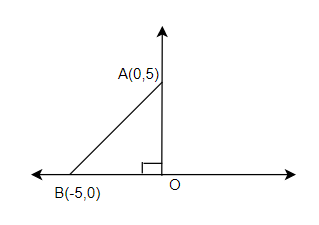
Answer
488.4k+ views
Hint: To solve this question, we should know about a few concepts of coordinate geometry like distance formula, that is distance between two points $\left( {{x}_{1}},{{y}_{1}} \right)$ and $\left( {{x}_{2}},{{y}_{2}} \right)$ can be calculated using the formula, $\sqrt{{{\left( {{x}_{1}}-{{x}_{2}} \right)}^{2}}+{{\left( {{y}_{1}}-{{y}_{2}} \right)}^{2}}}$. Also, we need to take care of the signs while solving this question.
Complete step-by-step solution -
In this question, we have been given two points, that is, (0, 5) and (-5, 0). And we have been asked to find the distance between them. For that we require the knowledge about distance formula of coordinate geometry, which states that distance between any two given coordinates like $\left( {{x}_{1}},{{y}_{1}} \right)$ and $\left( {{x}_{2}},{{y}_{2}} \right)$ is given by $\sqrt{{{\left( {{x}_{1}}-{{x}_{2}} \right)}^{2}}+{{\left( {{y}_{1}}-{{y}_{2}} \right)}^{2}}}$. Now, we will consider ${{x}_{1}}=0,{{y}_{1}}=5$ and ${{x}_{2}}=-5,{{y}_{2}}=0$. We will put these values in the distance formula, we get the distance between the two points (0, 5) and (-5, 0) as,
$\sqrt{{{\left[ 0-\left( -5 \right) \right]}^{2}}+{{\left[ 5-0 \right]}^{2}}}$
Simplifying it further, we get,
$\begin{align}
& \sqrt{{{\left[ 0+5 \right]}^{2}}+{{\left[ 5-0 \right]}^{2}}} \\
& \Rightarrow \sqrt{{{\left( 5 \right)}^{2}}+{{\left( 5 \right)}^{2}}} \\
\end{align}$
Now, we know that ${{5}^{2}}=5\times 5=25$. So, we will get the distance between (0, 5) and (-5, 0) as, $=\sqrt{25+25}$
Now, we know that 25 +25 = 50, so we will get $\sqrt{50}$. We know that 50 can be expressed as $25\times 2$, where 25 can be represented as ${{5}^{2}}$. So, we will get, $\sqrt{{{5}^{2}}\times 2}$, which can be further written as, $\sqrt{{{5}^{2}}}\times \sqrt{2}$. We know that the square root of square of any term gives us the same term, so we get, $5\sqrt{2}$. Hence, we can say that the distance between the points (0, 5) and (-5, 0) is $5\sqrt{2}$.
Therefore, the correct answer is option B.
Note: We can also solve this question by plotting points on graph and then applying the Pythagoras theorem. Like the figure below,

Now, we can see that triangle AOB is a right-angled triangle. So, by Pythagoras theorem, we can write, ${{\left( AO \right)}^{2}}+{{\left( OB \right)}^{2}}={{\left( AB \right)}^{2}}$ and we have AO = OB = 5. So, we will get ${{\left( 5 \right)}^{2}}+{{\left( 5 \right)}^{2}}={{\left( AB \right)}^{2}}$. And after simplifying this we will get, $AB=5\sqrt{2}$.
Complete step-by-step solution -
In this question, we have been given two points, that is, (0, 5) and (-5, 0). And we have been asked to find the distance between them. For that we require the knowledge about distance formula of coordinate geometry, which states that distance between any two given coordinates like $\left( {{x}_{1}},{{y}_{1}} \right)$ and $\left( {{x}_{2}},{{y}_{2}} \right)$ is given by $\sqrt{{{\left( {{x}_{1}}-{{x}_{2}} \right)}^{2}}+{{\left( {{y}_{1}}-{{y}_{2}} \right)}^{2}}}$. Now, we will consider ${{x}_{1}}=0,{{y}_{1}}=5$ and ${{x}_{2}}=-5,{{y}_{2}}=0$. We will put these values in the distance formula, we get the distance between the two points (0, 5) and (-5, 0) as,
$\sqrt{{{\left[ 0-\left( -5 \right) \right]}^{2}}+{{\left[ 5-0 \right]}^{2}}}$
Simplifying it further, we get,
$\begin{align}
& \sqrt{{{\left[ 0+5 \right]}^{2}}+{{\left[ 5-0 \right]}^{2}}} \\
& \Rightarrow \sqrt{{{\left( 5 \right)}^{2}}+{{\left( 5 \right)}^{2}}} \\
\end{align}$
Now, we know that ${{5}^{2}}=5\times 5=25$. So, we will get the distance between (0, 5) and (-5, 0) as, $=\sqrt{25+25}$
Now, we know that 25 +25 = 50, so we will get $\sqrt{50}$. We know that 50 can be expressed as $25\times 2$, where 25 can be represented as ${{5}^{2}}$. So, we will get, $\sqrt{{{5}^{2}}\times 2}$, which can be further written as, $\sqrt{{{5}^{2}}}\times \sqrt{2}$. We know that the square root of square of any term gives us the same term, so we get, $5\sqrt{2}$. Hence, we can say that the distance between the points (0, 5) and (-5, 0) is $5\sqrt{2}$.
Therefore, the correct answer is option B.
Note: We can also solve this question by plotting points on graph and then applying the Pythagoras theorem. Like the figure below,

Now, we can see that triangle AOB is a right-angled triangle. So, by Pythagoras theorem, we can write, ${{\left( AO \right)}^{2}}+{{\left( OB \right)}^{2}}={{\left( AB \right)}^{2}}$ and we have AO = OB = 5. So, we will get ${{\left( 5 \right)}^{2}}+{{\left( 5 \right)}^{2}}={{\left( AB \right)}^{2}}$. And after simplifying this we will get, $AB=5\sqrt{2}$.
Recently Updated Pages
Fill in the blanks with suitable prepositions Break class 10 english CBSE

Fill in the blanks with suitable articles Tribune is class 10 english CBSE

Rearrange the following words and phrases to form a class 10 english CBSE

Select the opposite of the given word Permit aGive class 10 english CBSE

Fill in the blank with the most appropriate option class 10 english CBSE

Some places have oneline notices Which option is a class 10 english CBSE

Trending doubts
Fill the blanks with the suitable prepositions 1 The class 9 english CBSE

How do you graph the function fx 4x class 9 maths CBSE

When was Karauli Praja Mandal established 11934 21936 class 10 social science CBSE

Which are the Top 10 Largest Countries of the World?

What is the definite integral of zero a constant b class 12 maths CBSE

Why is steel more elastic than rubber class 11 physics CBSE

Distinguish between the following Ferrous and nonferrous class 9 social science CBSE

The Equation xxx + 2 is Satisfied when x is Equal to Class 10 Maths

Differentiate between homogeneous and heterogeneous class 12 chemistry CBSE




